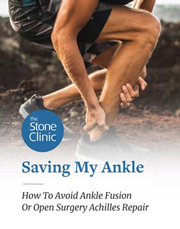BioAnkle
Biologic treatments for ankle injury and arthritis
What is BioAnkle®?
BioAnkle® is our program of biologic treatments to rebuild injured and arthritic ankles. At the San Francisco Foot & Ankle Center®, it starts with careful physical therapy to increase range of motion and optimize gait for people who have primarily soft tissue injuries to the ankle. Where indicated, physical examination and review of x-rays and MRIs are performed to help assess the source of pain and which treatments may be indicated to help regain function and reduce pain. Listed below are surgical treatments that comprise our BioAnkle® program.
Ankle instability
Debridement of built-up scar tissue followed by the rebuilding of the unstable ligaments usually provides for excellent stability of the ankle when combined with a guided, early exercise program focusing on range of motion, balance, stability, and strength training. The most common ankle instability is from a loose anterotibial ligament (ATFL). Dr. Stone modified a repair technique to provide a strong ligament reefing surgical procedure that has now been used at The Stone Clinic for thirty years and hundreds of patients. Each repair is now augmented with bioactive factors.
Articular cartilage repair
Articular cartilage injuries such as an OCD lesion of the talus or arthritic changes in the ankle can be treated by grafting the damaged articular cartilage using our articular cartilage paste graft technique. The technique involves the harvest of articular cartilage and underlying bone from the anterior lip of the distal tibia, although sometimes augmented by additional tibial bone, morselizing the damaged articular cartilage or OCD lesion and then packing the graft into the defect. This procedure is followed by four weeks of non-weight-bearing with CPM motion and then four to six months of careful rehabilitation strengthening, balance, and coordination program focusing on soft-tissue mobilization to return to full range of motion. Damaged articular cartilage in the ankle can be successfully regenerated to form a superb repair tissue that can last decades. Extensive arthrosis with eburnated bone on the distal tibia and talus may require ankle replacement or fusion. However, these are considered last steps after all BioAnkle treatments have been exhausted. The ankle cartilage has a remarkable ability to heal if given the correct stimulus. This may be why primary ankle arthritis without an injury is extremely rare.
Extensive arthrosis with eburnated bone on the distal tibia and talus may require ankle replacement or fusion. However, these are considered the last steps after all BioAnkle® treatments have been exhausted. The ankle cartilage has a remarkable ability to heal if given the correct stimulus. This may be why primary ankle arthritis without an injury is extremely rare.
Achilles tendon rupture repair
The Achilles tendon is a strong, broad tissue covered in a sheath. When it ruptures the sheath is usually intact with a healing blood clot that forms around the torn ends. Open surgery leads to a loss of that clot, scarring, and a slow recovery. When there's a rupture of the Achilles tendon, our percutaneous suture repair technique has shown to be effective over the last 25 years at repairing the ruptured Achilles tendon without open surgery and returning the patient back to sports. Our long-term data with MRI follow-up on torn Achilles tendons demonstrates that the tendons heal with a normal appearance on an MRI although slightly thicker than the normal Achilles tendon. The procedure is performed as an outpatient under local anesthesia.
